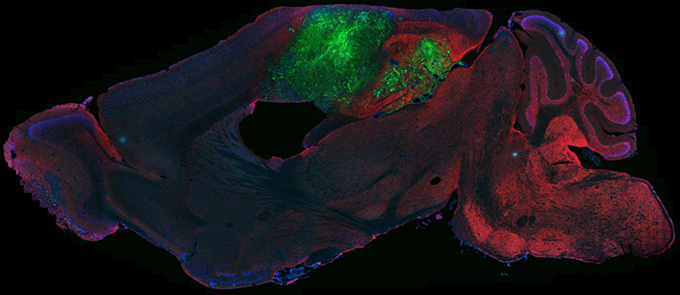Research Highlight
Origins of Aggressive Brain Tumors

Figure Caption: Tumorigenesis in the hippocampus and CTX of GFAP-Cre mice. Maximum intensity projectons of large-scale mosaic volumes of saggital sections. Red=The gap junction protein, Connexin43, antbodies; Green=GFP tumor marker, Blue=DAPI, a marker for the cell nucleus.
January, 2013 La Jolla -- Scientists have long believed that glioblastoma multiforme (GBM), the most aggressive type of primary brain tumor, begins in glial cells that make up supportive tissue in the brain or in neural stem cells. In a paper published in Science, researchers at the Salk Institute for Biological Studies and the National Center for Microscopy and Imaging Research have found that the tumors can originate from other types of differentiated cells in the nervous system, including cortical neurons.
GBM is one of the most devastating brain tumors that can affect humans. Despite progress in genetic analysis and classification, the prognosis of these tumors remains poor, with most patients dying within one to two years of diagnosis. This study offers an explanation for the recurrence of GBM following treatment and suggest potential new targets to treat these deadly brain tumors. To better understand this process, the Salk team headed by Inder Verma and Dinorah Friedmann-Morvinski harnessed the power of modified viruses, called lentiviruses, to disable powerful tumor suppressor genes that regulate the growth of cells and inhibit the development of tumors. With these tumor suppressors deactivated, cancerous cells are given free rein to grow out of control.
Dr. Verma and his colleagues attached small RNA molecules, known as short hairpin RNAs, to the modified viruses and injected them directly into very few cells in the brains of genetically engineered mice that express an enzyme known as CRE specifically in neurons, astrocytes or neural stem cells. The modified viruses target two genes -- neurofibromatosis 1 (NF1) and p53 -- that, when mutated, are implicated in severe gliomas like GBM. In collaboration with NCMIR scientists, Eric Bushong and Mark Ellisman and using the advanced light microscopy imaging capabilities developed by NCMIR, they discovered that neurons genetically converted by the lentiviruses that also produce green fluorescent protein (GFP) as a marker can be tracked to monitor the progression of tumors are capable of forming malignant gliomas.
Because the origin of glioblastomas from neurons has not been previously reported, the study provided further evidence that mature neurons can be transformed by these oncogenes by isolating cortical neurons from genetically engineered mice and transducing them with one of the lentiviruses. The neurons that were transplanted back into the mice developed the same tumors as the ones in the laboratory. Their results indicate that when two critical genes -- NF-1 and p53 -- are disabled, mature, differentiated cells acquire the capacity to reprogram [dedifferentiate] to a neuroprogenitor cell-like state, which can not only maintain their plasticity, but also give rise to the variety of cells observed in malignant gliomas.
If scientists can block the process of dedifferentiation or proliferation of dedifferentiated
neuroprogenitor cells, they may be able to stop tumor progression. An
aggressive disease like GBM has a high rate of recurrence. The scientists say the tumors in their mouse model are similar to GBMs that affect humans. Because they have the same pathology and characteristic genetic signature, potential therapies first tested in mice could potentially work in humans. While they may not eradicate GBM, these therapies may slow the progression of the disease and improve patients’ quality of life.
The work was supported by the National Institutes of Health, Ipsen/Biomeasure, the Leona M.
and Harry B. Helmsley Charitable Trust, the H.N. and Frances C. Berger Foundation, and the
NIH National Institute of General Medical Sciences.
Adapted from http://www.sciencedaily.com/releases/2012/10/121022162341.htm
Citation: Friedmann-Morvinski D, Bushong E, Ke E, Soda Y, Marumoto T, Singer O, Ellisman M, Verma I (2012) Dedifferentiation of neurons and astrocytes by oncogenes can induce gliomas in mice. Science 338:1080-4.
